The 1772 Silver Resolution & Adventure Medallion - Captain James Cook & Sir Joseph Banks Square Off
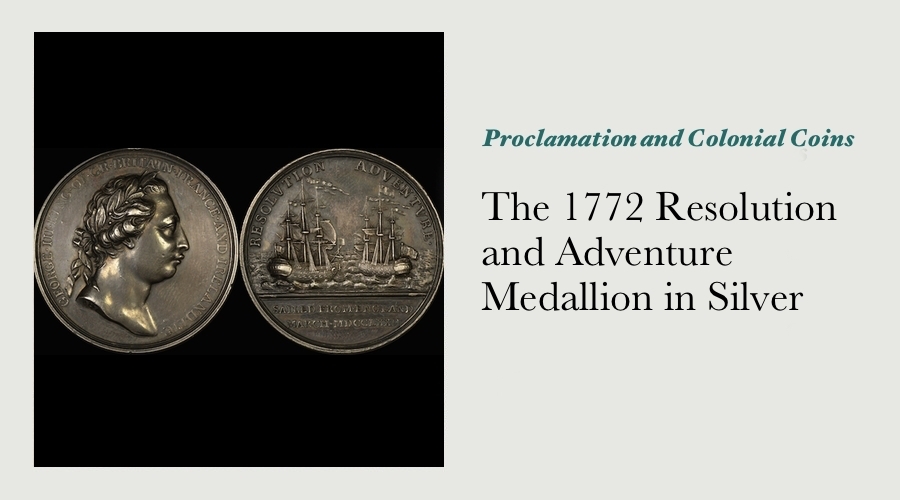
The silver Resolution and Adventure medallion commemorates Captain James Cook’s Second Voyage across the Southern Hemisphere, a pioneering journey that fundamentally changed the way the world was viewed.
It has long been regarded as a key item in Australian numismatics, and unequivocally rates as one of the most desirable items of Captain Cook memorabilia available. Not only does it remain a direct link to one of the greatest explorers the world has ever known, but it is also strongly connected to the man regarded by many as being “The Father of Australia”[1], Sir Joseph Banks.
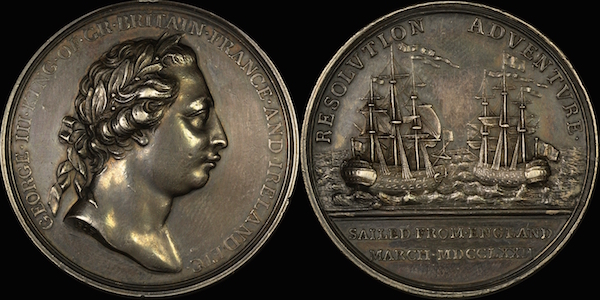
While the silver Resolution and Adventure medallion obviously brings to mind the exciting period of courage, curiosity and adventure of the late 1700s, what is less known is that it also embodies a showdown between two of the most formidable minds in 18th century England.
Although Sir Joseph Banks conceived the medals, played a key role in their design and planned how they were to be distributed, to his great disappointment he did not travel with Cook on his pioneering journey. The story of the Resolution and Adventure medal adds back a human element to the larger than life men that played fundamental roles in the foundation of Australia.
Captain James Cook: The Most Able and Enlightened Navigator England Ever Produced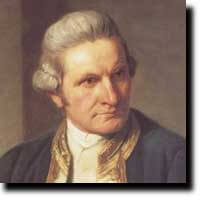
James Cook is known to every Australian schoolchild as captain of the “Endeavour” - the man that “discovered” Australia. A full description of Cook’s achievements is rather more detailed. Cook is respected by many as the world’s foremost explorer of his age, not only because he displayed a truly rare combination of skill and attention to detail, but also for his physical courage and ability to lead men under challenging conditions. In an era when sons of the working class were rarely considered for promotion, Cook’s natural talent was so great, he rose from being a humble seaman to the commander of three great voyages. His achievements in mapping the Pacific, New Zealand and Australia, radically changed the face of the world as many knew it, and in the words of a contemporary, proved him to be “the ablest and enlightened navigator that England ever produced.[2]”
Sir Joseph Banks - The Father of Australia
Sir Joseph Banks was an English naturalist, botanist and patron of the natural sciences. Because of his keen interest in the colony Banks has been called "the Father of Australia".[3] When the Royal Society persuaded the Admiralty (the English Royal Navy) to send Captain James Cook on his first voyage to observe the transit of Venus, it urged that “Joseph Banks … a Gentleman of large fortune … well versed in natural history”[4] should be permitted to join the expedition “with his Suite”.[5] The First Lord of the Admiralty is thought to have intervened to ensure this request was granted, and Banks joined with a staff of eight.[6])
While they were in Australia on this First Voyage, Banks, Daniel Solander and the Finnish botanist Dr. Herman Spöring Jr. made the first major collection of Australian flora, and described many species new to science. These men discovered so much new plant life that “Banks’ Florilegium”, an incredible work that spanned some 35 volumes, took a decade to print complete and in full colour, and was only finished in 1990. Banks returned to London from Cook’s First Voyage in July 1771, to immediate fame. He went on to hold the position of President of the Royal Society for over 41 years, he advised King George III on the Royal Botanic Gardens, advocated the establishment of Botany Bay as a place for the resettlement of convicts, and advised the British government on all matters relating to Australia.
Preparations for the Second Voyage
At the beginning of 1772, Banks and the Swedish naturalist Solander began making significant preparations to join Cook’s Second Voyage. Their entourage this time was to include no less than 16 people (double the size of their staff on the Endeavour), and included a painter and two horn players, not to mention far more botanical equipment than the Endeavour had lugged.[7]
In his personal journal during this period, Cook noted rather dryly that “it was found difficult to find room for the whole and at the same time leave room for her officers and crew and stowage for the necessary stores and provisions”[8]. Extensive modifications had to be made to the Resolution in order to (literally) accommodate Banks - he not only demanded exclusive use of the Captain’s cabin, but that a whole new deck be added on top of the existing deck (adding another level of accommodation), and that Cook instead be housed in a relatively small compartment built onto the new main deck.
While Cook had “reason to think that she would prove Crank and that she was overbuilt”[9], he “suspended giving any other opinion until a full trial had been made of her”[10]. (Cook uses the term “crank” to describe the Resolution’s tendency to easily “heel” or tip over.[11])
The Resolution’s Maiden Voyage
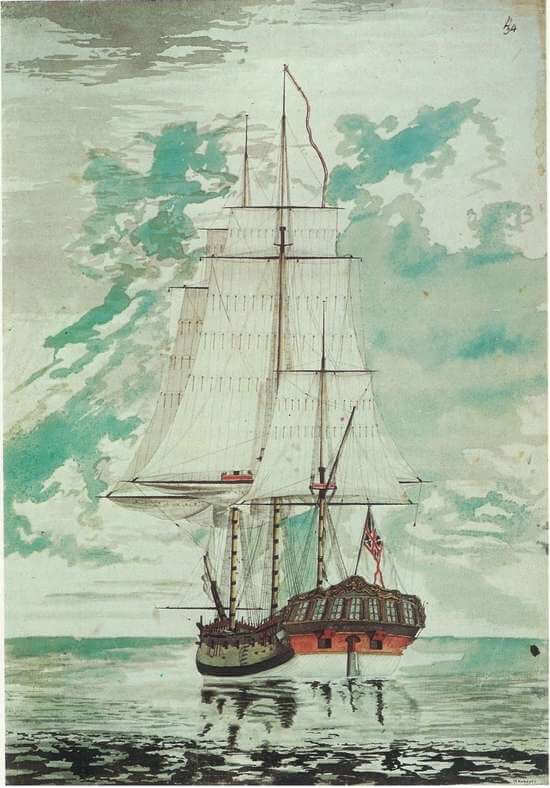
The Resolution’s maiden voyage was intended to run down the river Thames, and into the English Channel. So bad was the Resolution’s tendency to “crank” however that it took no less than 4 days to reach the mouth of the River Thames, and the pilot in charge refused to take her into the English Channel for fear of capsizing.
After that short journey, one of Cook’s senior staff reported to him that “By God ill go to sea in a grog tub, if desired, or in the Resolution as soon as you please, But I must say I think her by far the most unsafe ship I ever saw or heard of.[12]”
Cook immediately sought permission from Lord Sandwich (Lord of the Admiralty) to have the unsafe renovations completely dismantled - the new deck and sparhouse were removed, and within 48 hours, the Resolution was back to it’s original condition again.[13]
Not only would this mean that Banks and his party would now need to satisfy themselves with on-board accommodation that was rather more austere than they believed was appropriate, but as Banks had personally financed the renovations, he had in fact wasted £5,000.[14] To put that figure in perspective, the vessel had only cost the Admiralty £4,151 outright just a few months earlier.
Banks took the opportunity to personally inspect the newly-restored Resolution himself on May 28th, 1772. One account of that day’s events states that when he “…saw the changes for himself, he exploded. His tantrum was epic. Spectators said he “swore and stamped like a mad man.” Banks ordered all his entourage off. Then he had his baggage and personal effects removed.[15]”
Banks and Cook Square Off
The Admiralty and the Navy Board were asked to adjudicate - Cook commented: “I shall not mention the arguments made use of by Mr Banks and his friends as many of them were highly absurd … be this as it may the clamour was so great that it was thought it would be brought before the House of Commons.[16]” Cook goes on to state in his journal that “Mr Banks declared his resolution not to go the Voyage, alleging that the Sloop was neither roomy nor convenient enough for his purpose.[17]”
So there we have it, despite the existence of the Resolution and Adventure medal that indicates Banks had an intimate involvement with the planning of Cook’s second voyage, Banks did not travel with Cook on his famous Second Voyage.
The Mysterious Mr Burnett
Cook’s opinion of Banks must surely have been dented further when the Resolution made it’s the first port of call at Funchal, on the Portuguese island of Madeira on August 1st, 1772. The Resolution’s crew learned of a “mysterious gentleman” by the name of Burnett that had apparently been unable to board the ship in England, and was waiting to join Banks’ party as a botanist. A letter by Cook at the time stated that “Every part of Mr Burnett’s behaviour and every action tended to prove that he was a Woman. I have not met with a person that entertains a doubt of a contrary nature …"[18]
The inescapable conclusion was that Mr Burnett was in fact Banks’ mistress and that Banks had intended to smuggle her onto the Resolution. That Mr Burnett left Madeira on the first ship to England as soon as “he” heard the news that Banks was not on the Resolution did not help Mr Banks’ credibility. The poignancy of Mr Burnett’s efforts to join Banks on the Resolution is magnified further when we learn that Banks had departed London for Iceland some 3 weeks earlier.
"Testimonies of Being the First Discoveries..."
Prior to embarking on his Second Voyage, Cook wrote in his journal: "their Lordships also caus’d to be struck a number of Medals, on the one side the Kings head and on the other the two Sloops & the time they were at first intended to sail from England, these Medals are to be distributed to the Natives of, and left upon New Discoveried countries as testimonies of being the first discoveries".[19]
Sir Joseph Banks is known to have put the idea of a presentation medal to the Admiralty - he appreciated the political significance of issuing such medals as proof of discovery, and was aware that the French Admiral Bougainville had one struck for his voyage of 1766. “The medal, funded by the Admiralty, reflects the British government’s intentions to foster a good relationship with any indigenous people with whom Cook came in contact, as well as supporting territorial claims by providing evidence of being the first discoverers. In those times it was customary for Europeans to claim territory in the Pacific and elsewhere when seen for the first time by them.[20]” Correspondence in the papers of Sir Joseph Banks shows that in early in 1772, acting as the agent for the Admiralty, Banks placed an order with the firm of Boulton and Fothergill for a series of medals and jewellery items, with the intention that they be used as gifts or in barter with Pacific islanders. Banks ordered 2,000 medals in a base metal, as well as 142 in silver and two in gold.
Production Problems and the Delayed Voyage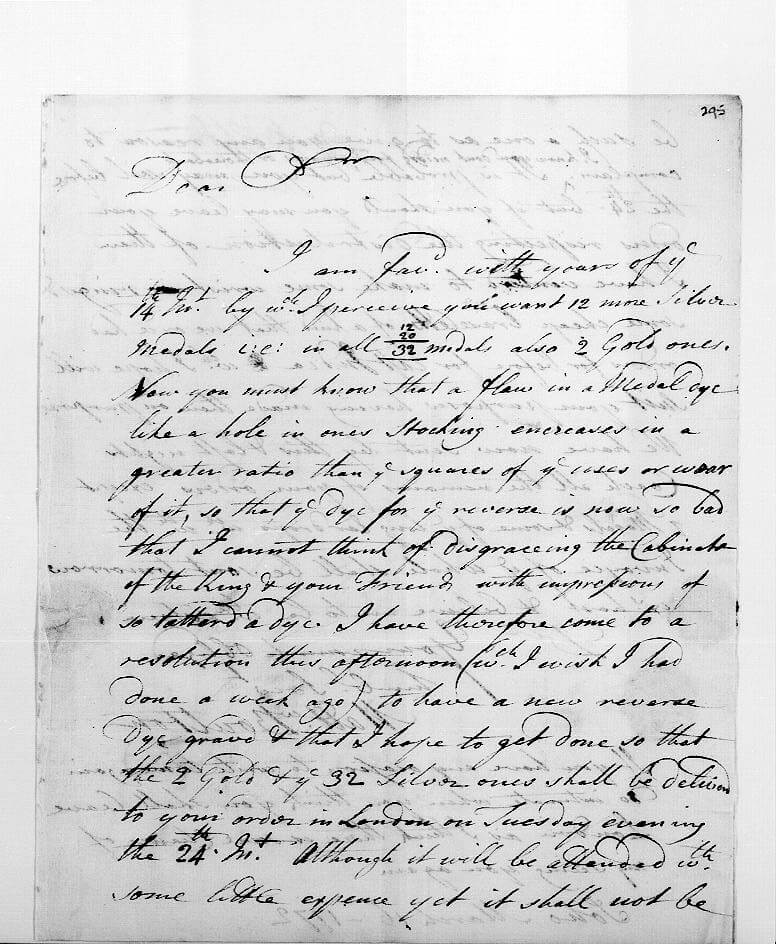
Since it took five blows to strike the silver medals and only one for the much softer Platina, Boulton planned to strike the silver medals first, while the die was new and showed little or no signs of wear. Unfortunately, the reverse die cracked on the ‘first blow’ of the silver medal, throwing Boulton’s production plan into disarray. A letter from Boulton to Banks shows that he did not want to supply Banks with medals showing any sign of a cracked die:
“Now you must know that a flaw in a Medal dye like a hole in one’s stocking increases in a greater ratio than ye square of uses or wear of it, so that ye dye for ye reverse is so bad that I cannot think of disgracing the Cabinets of the King & your Friend with impressions of so tattered a dye.[21]”
As there was insufficient time to make a new reverse die before the date Banks was to depart, and as Boulton thought the medals would good enough for the ’natives’, Boulton decided to make all of the 2,000 Platina medals using the cracked die. If time permitted, he intended to make a new reverse die, and strike the silver medals using it. Fortunately for Boulton, Banks’ extensive customisation of the Resolution meant that the voyage’s embarkation date had been delayed by at least a month. This allowed Boulton enough time to strike all of the medallions well before the expedition departed.
A Fundamental Part of Banks’ Planning
Many descriptions of Banks’ involvement with the Resolution & Adventure medals speak of depict Banks commissioning them almost as a benevolent patron - one far apart from the logistics of the voyage, but with a warm regard for the people and objectives concerned. The reality is however that these medals were a fundamental part of Banks’ planning for the Second Voyage - an expedition that he clearly intended to have a dominating influence over. Banks may very well have envisioned himself gifting medallions in exchange for new botanical specimens right across the Pacific, flora that he would have received further acclaim for upon his return to London. His conflict with Cook and the Admiralty over the available accommodation on the Resolution meant that Banks did not actually travel on the ships seen on the medals he commissioned. It is interesting to wonder whether Banks would have still commissioned Boulton to manufacture these medals had he never intended to travel with Cook on his Second Voyage, some might suspect the answer would be no.
With this in mind then, the Resolution and Adventure medals are a tangible reminder of the tumultuous and short-lived involvement of Sir Joseph Banks in Cook’s Second Voyage. Work on the medals did not begin until after the Resolution’s new deck was complete on February 2nd 1772, and Boulton had well and truly finished striking them at least a month before Banks withdrew from the expedition on May 28th 1772.
Once it became apparent that he would not be travelling back to the Southern Hemisphere with Cook, Banks departed on an expedition to Iceland in the company of Uno Von Troil, a Swede with an interest in Scandinavian antiquities, a man described as being “…one of his generation’s most knowledgeable and most learned men.[22]” Banks and Von Troil departed for Iceland on July 12th 1772. A cynic might say that is is no coincidence that this was just one day before Cook embarked on his Second Voyage on the Resolution. Banks returned from Iceland by way of Scotland and it’s islands and did not set out to return to London from Edinburgh until November 19th, 1772.[23]
Personal Distribution to Friends and Allies
Banks is often described as having the silver Resolution and Adventure medallions struck for personal distribution to his friends, this can only have started following his return from Iceland in November 1772. The question of if and whether Banks actually did distribute the silver medals in the months following his return to London is an interesting one. His expedition to Iceland “scarcely warranted anything more elaborate than the description of Staffa that he gave to Pennant and the little map of the island…”[24] Similarly, “…the results of the Newfoundland journey, though important, were comparatively sparse…”[25] We can presume then, that Banks had a choice in how he spent his time after returning to London from Iceland.
His main focus after returning from Iceland is said to have been to publish the results of “…his great Endeavour voyage, with its hundreds and hundreds of totally unknown plants, insects, fishes, reptiles, birds and mammals, required an equally great publication for the benefit of the learned world.[26]” One of Boulton’s final letters to Banks regarding the Resolution and Adventure medals asks for instructions as to how they should be distributed if Banks were to depart before production on them was complete, however there is no record of a response from Banks to that effect.
While Banks had no involvement with Cook’s Second Voyage after it departed, we can imagine that while he was immersed in the task of compiling his “Florilegium”, the written record of the natural curiosities and other artefacts that he brought back from the Southern Hemisphere, Banks may well have also distributed the silver medallions to friends and dignitaries in London that had an interest in his work, as well as in the benefits that subsequent voyages might bring.
The silver Resolution and Adventure medallions are an incredibly rare link to one of the world’s greatest explorers - the man that discovered Australia, and are a reminder of a project very dear to one of the world’s greatest natural scientists, Sir Joseph Banks.
Comparative Appeal and Value of the Resolution and Adventure Medallion in Silver
When we compare how the silver Resolution and Adventure medallion has fared through auctions in years past with other important Australian numismatic items sold at the same time, we can see their relative importance to Australian collectors.
One important auction was conducted by Spink (Noble) Auctions in Sydney in November 1981. Lot 423 in that sale was a Resolution and Adventure medallion in silver - it made a hammer price of $4,200. Other items in the same sale that also had a hammer price of $4,200 are as follows:
| LOT | ITEM | HAMMER |
2014 VALUE |
|---|---|---|---|
| 423 | 1772 Silver Resolution & Adventure medallion | $4,200 | $17,500 |
| 695 | Queensland, Government 1902 Five Pound Issued Note MVR# 1 Fine | $4,200 | $81,000 |
| 719 | Australia 1913 Ten Shillings Cerutty / Collins R#1c Serials: M 413653 Uncirculated | $4,200 | $315,000 |
| 941 | Australia 1921 Melbourne Square Pattern Kookaburra Halfpenny Type 2 FDC | $4,200 | $295,000 |
| 1314 | Australia 1925 Melbourne Penny Uncirculated | $4,200 | $17,500 |
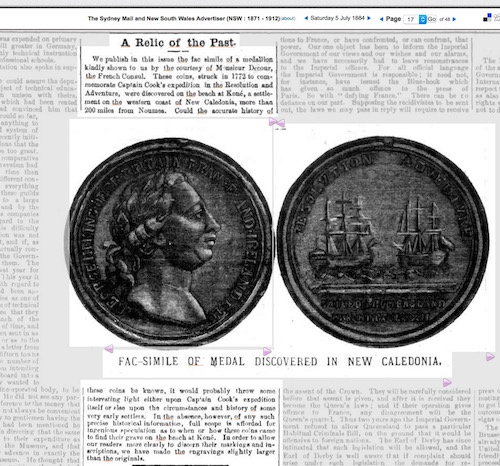
-
L. A. Gilbert, ‘Banks, Sir Joseph (1743–1820)’, Australian Dictionary of Biography, National Centre of Biography, Australian National University ↩
-
Hawke-Lockyer; Edward, “Memoirs of celebrated naval commanders”, Harding & Lepard, London, 1832, p 16. ↩
-
Rice; T, “Voyages of discovery: three centuries of natural history exploration.”, Natural History Museum, London, 1999. ↩
-
Cook; Captain James, “The Journals of Captain Cook”, Penguin Books, London, 2003 reprint, pcxxv. ↩
-
Cook; Captain James, “The Journals of Captain Cook”, Penguin Books, London, 2003 reprint. ↩
-
Cook; Captain James, “The Journals of Captain Cook”, Penguin Books, London, 2003 reprint. ↩
-
http://www.shipsnostalgia.com/guides/Nautical_Terms_A-D ↩
-
Dugard; Martin, “Farther Than Any Man: The Rise and Fall of Captain James Cook”, Pocket Books, New York, 2001, p 153. ↩
-
Cook; Captain James, “The Journals of Captain Cook”, Penguin Books, London, 2003 reprint, p284. ↩
-
Cook; Captain James, “The Journals of Captain Cook”, Penguin Books, London, 2003 reprint, p285. ↩
-
Dugard; Martin, “Farther Than Any Man: The Rise and Fall of Captain James Cook”, Pocket Books, New York, 2001, p 154. ↩
-
Cook; Captain James, “The Journals of Captain Cook”, Penguin Books, London, 2003 reprint, p.cxxviii. ↩
-
Cook; Captain James, “The Journals of Captain Cook”, Penguin Books, London, 2003 reprint, p.cxxix. ↩
-
O’Brian; P, “Joseph Banks: a Life”, University of Chicago Press, Chicago, 1987, p 163. ↩
-
Cook; Captain James, “The Journals of Captain Cook”, Penguin Books, London, 2003 reprint, p285. ↩
-
http://recollections.nma.gov.au/issues/vol_4_no1/notes_and_comments/captain_cooks_exploration_medals ↩
-
http://www2.sl.nsw.gov.au/banks/series_06/06_109.cfm ↩
-
Oxenstierna, p.74 ↩
-
Smith; Edward, “The Life of Sir Joseph Banks: President of the Royal Society”, Cambridge University Press, Cambridge, 2011 reprint, p 34. ↩
-
O’Brian; Patrick, “Joseph Banks”, Collins Harvill, London, 1987, p 168. ↩
-
O’Brian; Patrick, “Joseph Banks”, Collins Harvill, London, 1987, p 168. ↩
-
O’Brian; Patrick, “Joseph Banks”, Collins Harvill, London, 1987, p 168. ↩